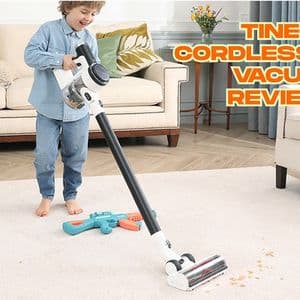Why Battery Life Matters in a Cordless Vacuum
Let’s face it: cordless vacuums are designed for convenience. But that convenience can quickly turn into frustration if the vacuum dies mid-clean.
Battery life directly affects how much ground you can cover before needing a recharge. For those with larger homes, stairs, or multiple floor types, a longer battery life can mean the difference between finishing the job in one go or stopping to recharge halfway through.
What Affects Battery Runtime?
Battery life isn't just about the number printed on the box. Several factors influence how long your cordless vacuum will actually last per charge. Here’s what to look for:
Battery Type and Capacity
Most modern cordless vacuums use lithium-ion batteries. These offer high energy density and fast recharge times, making them ideal for handheld devices. Look for models with batteries rated in watt-hours (Wh) or amp-hours (Ah)—higher numbers typically indicate longer potential runtimes.
Motor Power Settings
Running the vacuum at its highest suction level drains the battery much faster. Many models offer multiple power settings, and you can significantly extend battery life by using lower settings for light cleaning.
Brush Type and Attachments
Motorized brushes use more power than standard suction heads. If your vacuum is constantly running a high-powered brush, expect the battery to drain more quickly.
Dustbin Size and Maintenance
A full dustbin can reduce suction performance and efficiency, indirectly affecting runtime. Regularly cleaning filters and emptying the dustbin ensures consistent battery usage.
Realistic Expectations for Battery Life
So, how long is long enough?
Most cordless vacuums offer anywhere from 15 to 60 minutes of runtime, depending on the settings used. Models on the higher end of that range tend to feature larger batteries or dual-battery systems that allow for quick swaps and extended use.
Keep in mind:
-
On low settings, vacuums may run up to an hour.
-
On high settings, runtime could drop to 10–20 minutes.
-
Eco modes can help strike a balance between power and endurance.
Read more: Tineco Cordless Vacuums
Key Features to Look For
Here are some features that can help maximize both the battery life and overall cleaning performance of a cordless vacuum:
Swappable or Removable Batteries
Vacuums with removable battery packs give users the option to buy spares and double their effective cleaning time.
Fast Charging
Look for models that recharge fully in under 4 hours. Some offer fast-charge capabilities that provide a partial charge in less than an hour.
Intelligent Power Management
Some vacuums automatically adjust power based on floor type or dust level, optimizing battery consumption without manual input.
Cleaning Needs and Floor Type Matter
Let’s dive a little deeper. The size of your home and the types of surfaces you clean regularly play a big role in determining the ideal battery life for your needs.
-
Apartments or small homes: A single battery with around 30 minutes of runtime may suffice.
-
Larger homes: You’ll benefit from a vacuum with at least 45 minutes of runtime or the ability to swap batteries.
-
Multiple floor types: Switching from hardwood to carpet can increase power demands and reduce runtime.
If you're not sure where to start, many buyers often wonder: which Dyson is best for long battery life? While that question varies based on use case, it highlights how runtime has become a key differentiator in today’s market.
How to Maintain Battery Performance
Just like any rechargeable device, a vacuum's battery degrades over time. But there are steps you can take to prolong its lifespan:
Charge Wisely
Avoid leaving the battery on the charger indefinitely. Most modern chargers stop when full, but prolonged charging cycles can still wear the battery faster.
Store at Moderate Temperatures
Extreme heat or cold can damage lithium-ion batteries. Store the vacuum and battery indoors in a cool, dry place.
Avoid Full Drains
It’s better to recharge before the battery completely dies. Lithium-ion batteries perform best when kept between 20% and 80% capacity.
Common Myths About Battery Life
It’s easy to get swept up in marketing claims. Here are a few myths you should be aware of:
Myth 1: Higher Voltage = Better Battery
Not necessarily. While voltage affects motor power, it doesn’t directly determine how long the vacuum will run. Runtime is more closely linked to battery capacity and efficiency.
Myth 2: More Expensive Means Longer Life
Price does not always guarantee better battery performance. Some of the most affordable models offer decent runtimes for basic needs. In fact, shoppers looking for the cheapest stick vacuum cleaner often find that budget-friendly models still get the job done in small spaces.
How to Compare Cordless Vacuums by Battery Specs
Reading product specs can be overwhelming. Here’s a quick breakdown of what matters:
| Spec | What It Tells You |
|---|---|
| Voltage (V) | Affects motor power, not necessarily runtime. |
| Amp-hours (Ah) | Indicates capacity—the higher, the better. |
| Watt-hours (Wh) | Shows total energy stored; useful for runtime comparisons. |
| Charging Time | Impacts how quickly you can use the vacuum again. |
| Number of Batteries Included | Some models come with two batteries—great for larger jobs. |
Always check if the stated runtime refers to the lowest power setting or includes real-world usage across different modes.
Final Thoughts
A cordless vacuum with long battery life is more than just a convenience—it’s a tool that supports consistent, hassle-free cleaning, especially for larger areas or multi-surface homes. But not all batteries are created equal.
To choose wisely, consider your home size, the kind of dirt you tackle daily, and how long you typically spend cleaning. Battery specs, motor settings, and design features all come into play, and understanding how they interact can help you find a vacuum that lasts—not just per charge, but for years to come.










